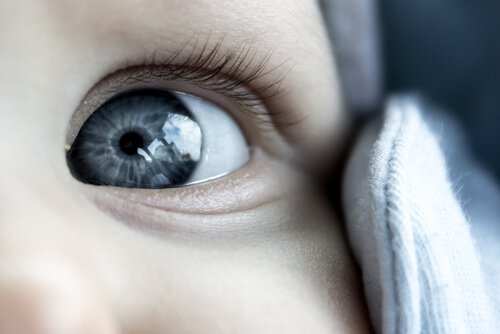Why Are Babies Born With Gray Eyes?

Why are babies born with gray eyes? This is a very common question that mothers have when they meet their newborn child, especially first-time mothers.
Seeing a baby’s gray eyes is charming and attracts the attention of anyone who looks at them.
The baby’s eye color will change during the first few months of life, becoming darker or lighter and losing the gray tone. But you may be wondering: Why does this happen? Why are babies born with gray eyes?
Understanding why babies are born with gray eyes
Melanin is responsible for this interesting eye color in babies. This substance gives the iris its pigmentation.
In reality, it’s not that the color changes, but that it begins to be defined. The newborn has immature melanin cells, but his production continues non-stop. As the baby grows, the cells mature, and this causes the color change. You can see this around the age of 6 months.
By 8 months, the child has a more defined eye color, also known as the marked pigmentation of the iris.
Genetics and eye color
The maturation of melanocytes and stimulation from the sun generate the melanin that gives color to the iris.
There is no specific rule yet to determine a baby’s eye color. This will depend on the parents’ genetic inheritance.
Eye color is designated by genes. Dark colors are given by dominant genes and light colors by recessive ones.

When will the baby’s eye color be defined?
It isn’t known when a child’s true eye color will be established. This is an individual process, very similar to hair growth, so it happens in different ways with each infant.
At five months old, the baby may have the eye color that he’ll have for life. But it could also take up to seven months or even a year. Everything depends on how his cells mature.
In general, we can say that the process in which the pigmentation of the iris changes into the final eye color begins around five months of age and ends around the age of two.
As the baby grows, the melanin cells mature, and this causes the color change. It can be seen by the age of 6 months.
Caring for the newborn baby’s eyes
At birth, babies are very delicate. They’re exposed very quickly to infections, since their immune system hasn’t fully developed.
In that sense, the eyes are usually the most affected. However, steps can be taken to prevent these types of problems:
Eliminate eye discharge
When the baby has this condition, it’s good to have health-grade saline at hand. If you have a dropper, even better. Place the baby on his back and put two drops in each eye. You should move his head from one side to another so that the serum covers the eyes completely.
Using gauze or towels
Gauze or towels are very practical for cleaning the eyelids. Needless to say, they must be sterile and moist.
In order to avoid the spread of infections, it is recommended that you use a different wipe or gauze for each eye. To clean the eye with these implements, wipe from the inside of the eyelids to the tear duct. This procedure can be done twice a day: upon waking and after bathing.

Conjunctivitis
Conjunctivitis is a bacterial or allergic disease that occurs in the form of swollen eyelids and red eyes.
The child will have difficulty opening his eyes, since the discharge will reproduce quickly. In these cases, trying to keep the eyes clean with serum is ideal.
To prevent this annoying pathology, excessive eye care and hygiene are necessary. So is keeping your hands clean and constantly hydrating this important organ.
We must also be careful not to expose our babies to very bright lights or strong sunlight during his first few days of life. It is advisable to keep him in a dimly lit room so that his eyes can be cleaned properly while they’re wide open.
Enjoy those lovely gray eyes to the fullest while your child has them. But remember: when they turn their true color, you’ll be even more in love with your baby.
Why are babies born with gray eyes? This is a very common question that mothers have when they meet their newborn child, especially first-time mothers.
Seeing a baby’s gray eyes is charming and attracts the attention of anyone who looks at them.
The baby’s eye color will change during the first few months of life, becoming darker or lighter and losing the gray tone. But you may be wondering: Why does this happen? Why are babies born with gray eyes?
Understanding why babies are born with gray eyes
Melanin is responsible for this interesting eye color in babies. This substance gives the iris its pigmentation.
In reality, it’s not that the color changes, but that it begins to be defined. The newborn has immature melanin cells, but his production continues non-stop. As the baby grows, the cells mature, and this causes the color change. You can see this around the age of 6 months.
By 8 months, the child has a more defined eye color, also known as the marked pigmentation of the iris.
Genetics and eye color
The maturation of melanocytes and stimulation from the sun generate the melanin that gives color to the iris.
There is no specific rule yet to determine a baby’s eye color. This will depend on the parents’ genetic inheritance.
Eye color is designated by genes. Dark colors are given by dominant genes and light colors by recessive ones.

When will the baby’s eye color be defined?
It isn’t known when a child’s true eye color will be established. This is an individual process, very similar to hair growth, so it happens in different ways with each infant.
At five months old, the baby may have the eye color that he’ll have for life. But it could also take up to seven months or even a year. Everything depends on how his cells mature.
In general, we can say that the process in which the pigmentation of the iris changes into the final eye color begins around five months of age and ends around the age of two.
As the baby grows, the melanin cells mature, and this causes the color change. It can be seen by the age of 6 months.
Caring for the newborn baby’s eyes
At birth, babies are very delicate. They’re exposed very quickly to infections, since their immune system hasn’t fully developed.
In that sense, the eyes are usually the most affected. However, steps can be taken to prevent these types of problems:
Eliminate eye discharge
When the baby has this condition, it’s good to have health-grade saline at hand. If you have a dropper, even better. Place the baby on his back and put two drops in each eye. You should move his head from one side to another so that the serum covers the eyes completely.
Using gauze or towels
Gauze or towels are very practical for cleaning the eyelids. Needless to say, they must be sterile and moist.
In order to avoid the spread of infections, it is recommended that you use a different wipe or gauze for each eye. To clean the eye with these implements, wipe from the inside of the eyelids to the tear duct. This procedure can be done twice a day: upon waking and after bathing.

Conjunctivitis
Conjunctivitis is a bacterial or allergic disease that occurs in the form of swollen eyelids and red eyes.
The child will have difficulty opening his eyes, since the discharge will reproduce quickly. In these cases, trying to keep the eyes clean with serum is ideal.
To prevent this annoying pathology, excessive eye care and hygiene are necessary. So is keeping your hands clean and constantly hydrating this important organ.
We must also be careful not to expose our babies to very bright lights or strong sunlight during his first few days of life. It is advisable to keep him in a dimly lit room so that his eyes can be cleaned properly while they’re wide open.
Enjoy those lovely gray eyes to the fullest while your child has them. But remember: when they turn their true color, you’ll be even more in love with your baby.
This text is provided for informational purposes only and does not replace consultation with a professional. If in doubt, consult your specialist.








